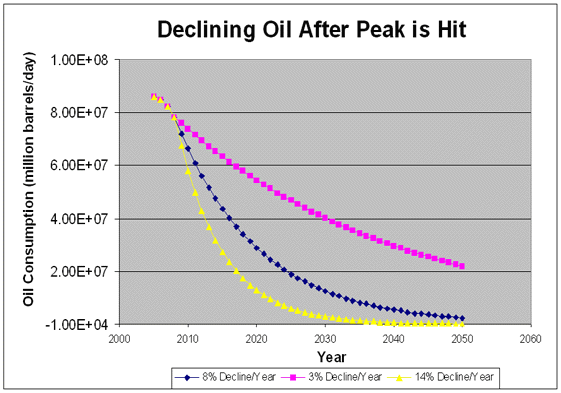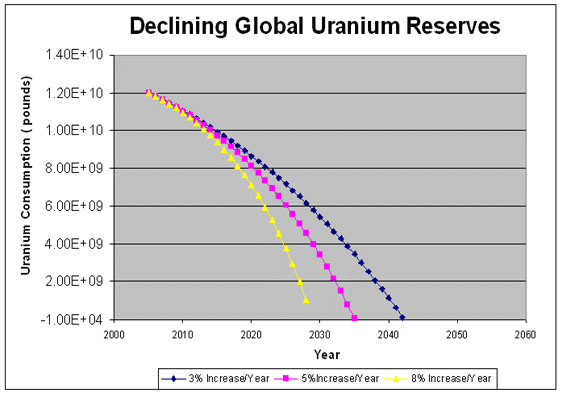|
TUESDAY EDITION December 16th, 2025 |
|
Home :: Archives :: Contact |
 |
Peak Oil and What It Means to YouDavid Petch
Peak oil has been of hot debate lately, with many naysayers saying there is a huge oil well to the center of the planet. With the Mexican Cantarell Oil field expecting to decline at 15% year over year and the Saudi Arabian Ghawar Oil field in a similar predicament, it seems that peak oil will occur in 2005 or 2006 at the very latest. This article explores oil and uranium depletion rates at different percentages year over year and the results are startling to say the least. I thought problems would not be seen for 10-15 years.guess again. The chart below shows what projected oil decline curves will look like with different rates of decline from oil fields collectively. Currently, global demand is at 86 million barrels/day. Peak oil will likely see 2-4 years of sideways movement, with output remaining within 2-4%. Subsequently though, the dynamics of global oil depletion will fall into one of the following scenarios. The 3% decline is the "best case scenario." If everyone shows spirit in humanity and cut back on energy usage, this could occur. As per the article above, 8% appears to be the benchmark for declines in oil production after a well has passed peak utilization. Declines of 14% can be expected from fields such as Ghawar in Saudi Arabia that have been pumped full of seawater and mined hard. After peak oil hits, the initial 3 years to follow will see a decline, but not terribly noticeable. However, as the laws of compounding kick in, the three lines part down separate trails. The higher the percent decline year over year (YOY), the more concave the decline. Our global politicians should have prepared decades ago for the pending crisis, because the trend that occurs will dictate how hard society crashes and how high the human toll will be: the 3% curve will see global oil production fall by 50% in 2030, the 8% curve (realistic) will see global oil production fall by 50% in 2016 and 14% curve would see global oil production fall by 50% in 2013.
Figure 1

The Canadian Oil Sands are being viewed as the next Saudi Arabia, but the cost of separation currently uses 10% of natural gas in Canada. There are other technologies being developed (Sequoia Interests, Earth Energy to name a few) that facilitate the separation of oil from sand in tepid water, requiring 75-85% less energy than current procedures. Oil sands will slowly fill the gap. Generally it takes 8-10 years to construct nuclear reactors or have an energy program in place so transitions are smooth. The prior chart suggests that once peak oil does occur, there will be a lull for 2-3 years before things get interesting. By time oil sand projects are underway, the supply produced will barely balance the year over year decline in oil production from major oil wells. Invest in some of these plays now before they become unreachable in price. As mentioned in an article a few months ago, there are know Uranium deposits of 6 billion pounds globally, with annual consumption of 180 million pounds. Figure 2 illustrates the different projections of uranium depletion, pending an increase in annual consumption rates of 3%, 5% or 8%. Currently, uranium production falls incredibly short of the demand. As oil resources become scarce, uranium will have more pressure put upon it as a resource. All three different scenarios have a similar course until around 2013, where they part trails. By 2020, there is a serious uranium shortage.
Figure 2

Let's assume a Pollyanna position and assume that uranium deposits can be doubled up in the coming decade. Figure 3 illustrates the 3 different scenarios, depending on the net increase in consumption per year. Rather than 2013 being a focal year, it is stretched out by 3 years to 2016.
Figure 3

The upper end of the percentage increases in yearly uranium demand is likely to occur, rather than a paltry 3%/year. The dynamics of all three curves assume demand is constant. As society moves down the road of declining oil production, there will be evolutionary inventions that will be revolutionary, death, death of the automobile etc. causing the curves to become skewered, likely a gentler slope. The important point to focus on is change, it is coming quickly and silently, like a thief in the night. One important aspect of population studies can be quickly demonstrated by growing a bacterial culture or mammalian culture. The hypothetical growth phase of a mammalian culture is shown in Figure 4 (excuse the CFU/mL (colony forming units/mL), should be cells/mL) for this example. The stationary phase is rather staggered, since the death phase usually occurs shortly after cells reach a peak density. Glucose is a commonly used nutrient by bacteria and it is present at a specified concentration upon culture inoculation. Reaching the stationary phase is a result of nutrient depletion. Glucose metabolism has many branch points, but one important part of the pathway is the conversion to lactate (waste product). Two lactate molecules are produced from one molecule of glucose. When glucose is totally consumed, lactate is often utilized by scavenging pathways for an energy source. This can be superimposed upon the current human population and why inflation is a more likely route than deflation in the coming 5-7 years. In mammalian, or bacterial cultures, growth occurs until energy demands do not balance the requirements for growth. Resources are squeezed until there is not enough and a population decline ensues. This can be translated easily into the current global climate where oil (glucose) is nearing depletion and alternatives such as uranium and oil sands (lactate) must be used to prevent the inevitable disruption in society.
Figure 4

The coming 7 years are going to be a critical juncture for our global community. When resources become scarce, as the old one loaf of bread amongst a crowd of 30, the highest bidder eats and the rest go hungry. That one loaf could go for $400 and the baker could make one a day and live well. When all the unfed people die, the price declines because there is a reduced demand. This scenario is applicable to oil and other energy sources. The price during the initial shortages will be driven sky high, but once the structural implications begin to ripple through the fabric of society, the inflation will end and deflation will ensue. Down the declining population curve, commodity prices likely will remain high, but to a much lesser extent than the top of the commodity bull, not expected to top out until 2011-2014ish. The human population will likely reach a stable range and remain range bound for the remaining of the species existence. The human population could survive for 100,000 years or longer, but will NEVER reach a population that currently is in place; there simply would not be the energy available to support a comparable infrastructure again. Politicians should quickly focus on maintaining railroad structure and forget about road infrastructure because 30 years from now, they will be really good bike paths. People of the future will stand in awe at the expansion of society and how those buildings and infrastructure were supported. The main focus of this editorial was to bring to light the importance of financial planning during the next 5-7 years. Reduction of debt and the importance of making hay while the sun is still shining are of utmost importance. All of the different indices I follow ultimately unify into a common thread, with each element necessary for functionality. As many know, Elliott Wave analysis as other forms of TA are fluid, with several possibilities, many often eliminated when certain technical objectives have been met or fail. Using Elliott Wave analysis as a probability tool for trading can greatly reduce the risk of investing. I focus on using Glenn Neely's approach to Elliott Wave analysis from his classic book "Mastering Elliott Wave" (of which has been expanded with various web articles over the past 15 years). Although it is one of the most complex forms of technical analysis on the planet, it has provided accurate results for the indices I cover: 10 Year US Treasury Index, AMEX Gold BUGS Index, AMEX Oil Index, and US Dollar Index. With the coming problems defined in this article, our analysis attempts to maximize investor's returns by being properly positioned at critical junctures in the market. David Petch
Treasure Chests is a market timing service specializing in value based position trading in the precious metals and equity markets, with an orientation geared to identifying intermediate-term swing trading opportunities. Specific opportunities are identified utilizing a combination of fundamental, technical, and inter-market analysis. This style of investing has proven to be very successful for wealthy and sophisticated investors, as it reduces risk and enhances returns when the methodology is applied effectively. Those interested discovering more about how the strategies described above can enhance your wealth; please visit our web site at http://www.treasurechests.info.
Disclaimer: The above is a matter of opinion and is not intended as investment advice. Information and analysis above are derived from sources and utilizing methods believed reliable, but we cannot accept responsibility for any trading losses you may incur as a result of this analysis. Comments within the text should not be construed as specific recommendations to buy or sell securities. Individuals should consult with their broker and personal financial advisors before engaging in any trading activities. Do your own due diligence regarding personal investment decisions.
Copyright ©2005 www.treasurechests.info. All rights reserved.
Unless otherwise indicated, all materials on these pages are copyrighted by www.treasurechests.info. No part of these pages, either text or image may be used for any purpose other than personal use. Therefore, reproduction, modification, storage in a retrieval system or retransmission, in any form or by any means, electronic, mechanical or otherwise, for reasons other than personal use, is strictly prohibited without prior written permission. |
| Home :: Archives :: Contact |
TUESDAY EDITION December 16th, 2025 © 2025 321energy.com |
|